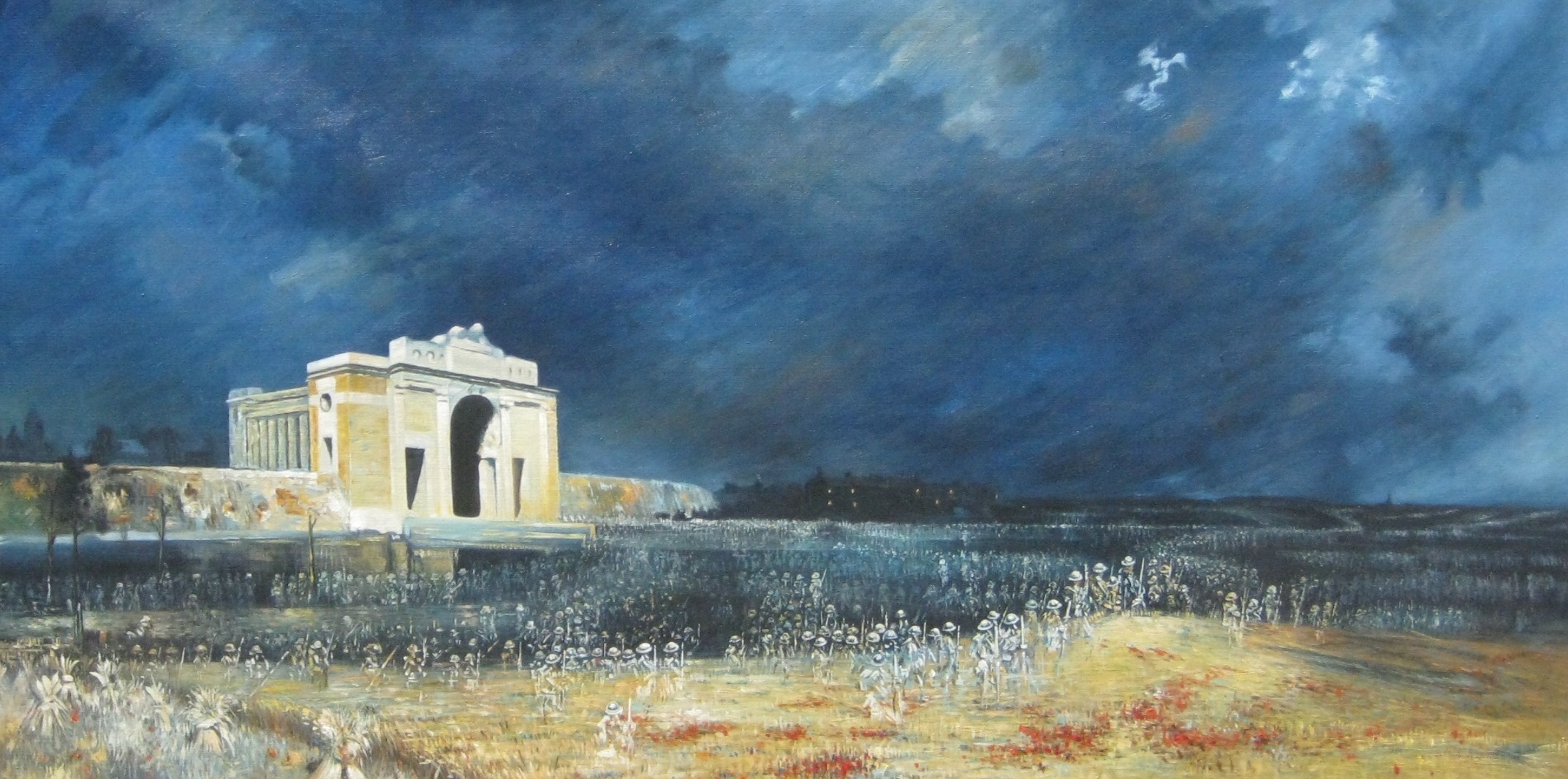 Menin Gate at Midnight is a 1927
painting by Australian artist Will Longstaff. The painting depicts a
host of ghostly soldiers marching across a field in front of the
Menin Gate war memorial. Bramwell Brown is one of the 55,000
soldiers memorialised there.
Menin Gate at Midnight is a 1927
painting by Australian artist Will Longstaff. The painting depicts a
host of ghostly soldiers marching across a field in front of the
Menin Gate war memorial. Bramwell Brown is one of the 55,000
soldiers memorialised there.
Bramwell Brown (1883-1917)

Line of Descent
to
Helen Glenmire Davidson
Hannah Brown
▼
Bramwell (brother of)
Isabella Jane Martin
▼
Helen Glenmire Davidson
return to the Davidson Family Tree
- Birth:
- 11 April, 1883, Brighton Workhouse, Sussex
- Mother:
- Hannah Brown
- Marriage:
- Rhoda Everest, 24 December 1904, Newhaven, Sussex
- Children:
- Florence Margaret, b. 21 Oct 1905, Hurstpierpoint, Sussex
- Alfred John b. 29 Jul 1907, Newhaven, Sussex
- Elsie Elizabeth, b.1910, Beddington, Sussex
- Death:
- 31 July, 1917, Ypres, Belgium (Battle of Passchendaele)
 There's no escaping the fact
that England's workhouses in the nineteenth century, both in London
and the provinces, were not places that anyone would go to
voluntarily. But, for the country's poor, there was often no
alternative, particularly if you were homeless and a pauper, as 27
year old Hannah Brown seems to have been. Her only skills were
domestic - she was recorded in the census of 1881 as a "cook,
servant", and so when she found herself unmarried and pregnant in the
summer of 1882, her only shelter when her time came to give birth in
April 1883, was in a workhouse.
There's no escaping the fact
that England's workhouses in the nineteenth century, both in London
and the provinces, were not places that anyone would go to
voluntarily. But, for the country's poor, there was often no
alternative, particularly if you were homeless and a pauper, as 27
year old Hannah Brown seems to have been. Her only skills were
domestic - she was recorded in the census of 1881 as a "cook,
servant", and so when she found herself unmarried and pregnant in the
summer of 1882, her only shelter when her time came to give birth in
April 1883, was in a workhouse.
(right): The Brighton Workhouse, where Bramwell was
born.
The workhouse, housed in a reasonably new majestic building, may not have been as harsh as other such establishments. Fifteen years earlier, the Lancet published a letter from Dr E. Russell, the medical Officer to the Brighton workhouse, in which he praised the conditions there. He noted that :
"the lying-in [labour] wards held a large preponderance of single woman, mostly servant girls....(but) the death rate among infants was unaccountably high... (nevertheless) we consider it in all respects a model [workhouse]".
Hannah took her infant son away from Brighton, ending up in East Grinstead, 60km north. There she met a newly-widowed farm worker, 70 year old William Martin, and so Bramwell gained a stepfather when the vastly-unsuited couple married in 1890. Despite the arrival of a little sister for Bramwell, the couple parted within a few years, with Hannah taking both children with her when she found work away from the Martin household.
The next official record of Bramwell comes with the 1901 census, where he is described as a 16 year old greengrocer's assistant, living in Newhaven, Sussex, with his employer's family. Newhaven is a channel ferry port, some 13km east of his Brighton birthplace.
In Newhaven, he met a young girl, of his own age, Rhoda Everest the daughter of a farm worker, and although Bramwell had moved away from the town to Hurstpierpoint, north of Brighton, the couple married in Newhaven's Christchurch on Christmas Eve 1904. On his marriage documentation, his occupation was given as a gardener.
Rhoda and Bramwell made their first home in Hurstpierpoint, and were living there when their first child, a daughter Florence was born 10 months later.
Getting employment often meant moving around southern Sussex. Their second child, a son, Alfred, was born back in Newhaven and their second daughter Elsie came when the family were living in Beddington. By that time, Bramwell was working as a cowman on a farm. a mere six kilometres outside Brighton.

Meanwhile, the storm clouds were gathering across Europe and stories of war just across the Channel, after the outbreak of hostilities in 1914, would have been heard clearly in southern England. Within a year, Bramwell answered the call. He signed up in October 1915, and was sent to serve in the Royal Army Medical Corps, before transferring to the Hertfordshire Regiment in July 1916. Six months later, he landed in France.
The bare, unemotional lines in his military record then simply notes "Missing" on 31 July 1917 - the first day of the bitter fighting that surrounded the battle known as Passchendaele, the third battle of the Ypres campaign. The next line says Private Brown was to be regarded officially has having been killed on that date - but his body, along with 55,000 others lost in the Ypres campaign, was never recovered. Passchendaele has been described as "a vivid symbol of the mud, madness, and senseless slaughter of the Western Front".
Bramwell's name is one of the more than 50, 000 names inscribed on the Menin Gate (right) at the entrance to the town of Ypres.
back to the Davidson Family Tree